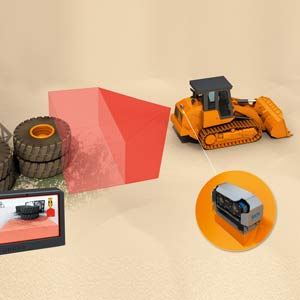SICK, the global sensing and imaging specialist, has launched the Visionary-B, an outdoor collision warning system that alerts operators of industrial vehicles and mobile machinery to the risk of ‘blind spot’ accidents.
SICK developed the Visionary-B driver assistance system by integrating the latest 3D imaging camera technology with exterior sensors and an in-cab monitor to create an intelligent system that monitors the area around or behind a vehicle and reliably detects both people and objects. It consistently identifies hazards in real time by detecting people or objects that are not part of the machine's normal working environment, then provide a visible and audible warning to the operator. As a plug-and-play system, the Visionary-B can be fitted to new vehicles or retrofitted to existing plant and equipment.
The Visionary B is based on SICK’s first robust, industrial imaging camera for outdoor use. Its high-resolution stereo camera technology captures 3D data with a single ‘snapshot’, whether the object is stationary or moving. Even when faced with poor light conditions, rain or dust, the SICK Visionary B’s imaging technology enables it to deliver high precision results. Unlike 3D vision systems based on laser triangulation, the 3D image is captured with one shot of light, without the need to profile a moving object. It also offers more reliable detection than other conventional technologies such radar or ultrasonic systems and it does not require an additional 2D camera to achieve a depth image.
“Manoeuvring and reversing are the most frequent causes of accidents involving mobile machines,” explains Neil Sandhu, SICK’s National Product Manager for Imaging, Measurement, Ranging and Systems. “In contrast to passive monitoring systems, with the Visionary B a driver does not need to keep checking a monitor but can be safe in the knowledge that the system will give a warning in real time if a person or obstruction enters the pre-defined detection zone.
“The system can capture the size and shape of moving or stationary objects and their distance from the vehicle within a 6 metre range. Furthermore, it can be set up to distinguish between different objects depending on their importance for collision warning purposes.
“The combination of stereoscopic imaging technology and intelligent processing on board the Visionary B’s camera means it achieves reliable results over a wide range of conditions, with less false imaging than can occur with some of other more commonly-used systems.”
Three versions are available to suit the application: KIT A is suitable for the most vehicle types; KIT B offers the option of two separate detection areas with two sensors, which can be activated according to the engaged gear, useful, for instance, when manoeuvring backward and forward in narrow areas where turning is difficult. KIT C can be used where a vehicle’s design prevents complete observation of the desired area from the cab, with two sensors working simultaneously for extended field views.
The Visionary-B camera is designed to capture more than 25,000 distance and intensity values to create real time 3D images at up to 30 frames per second. It builds up a detailed and accurate real-time 3D image of fixed or moving objects regardless of angle, surface finish, material or shape of object by combining different aspects of the light scattered by the object for a detailed picture of shape, distance, reflectivity and object depth.
The system is simple to set up and the importance of images can be “taught in” for recognition and warning. The cab monitor enables easy menu-led configuration and assessment and the unit records the previous hour of activity for review where required.
The camera sensor head, mounted on the vehicle exterior, has a rugged IP69K housing with a temperature range of -40°C to +75°C. The IP67 evaluation unit is cab-based, with a temperature range of -20°C to +75°C.
Easy to mount, either on a vehicle or frame at the optimum angle for operation, the SICK Visionary-B is fitted with an industrial standard API connector for easy communication of the 3D data for evaluation on an external computer. Data can be read or recorded either directly via SICK’s SOPAS interface or via API for matlab, java or C++, and the SICK Visionary-B is compatible with SICK’s IDpro platform for integration with other SICK vision and sensor devices.
